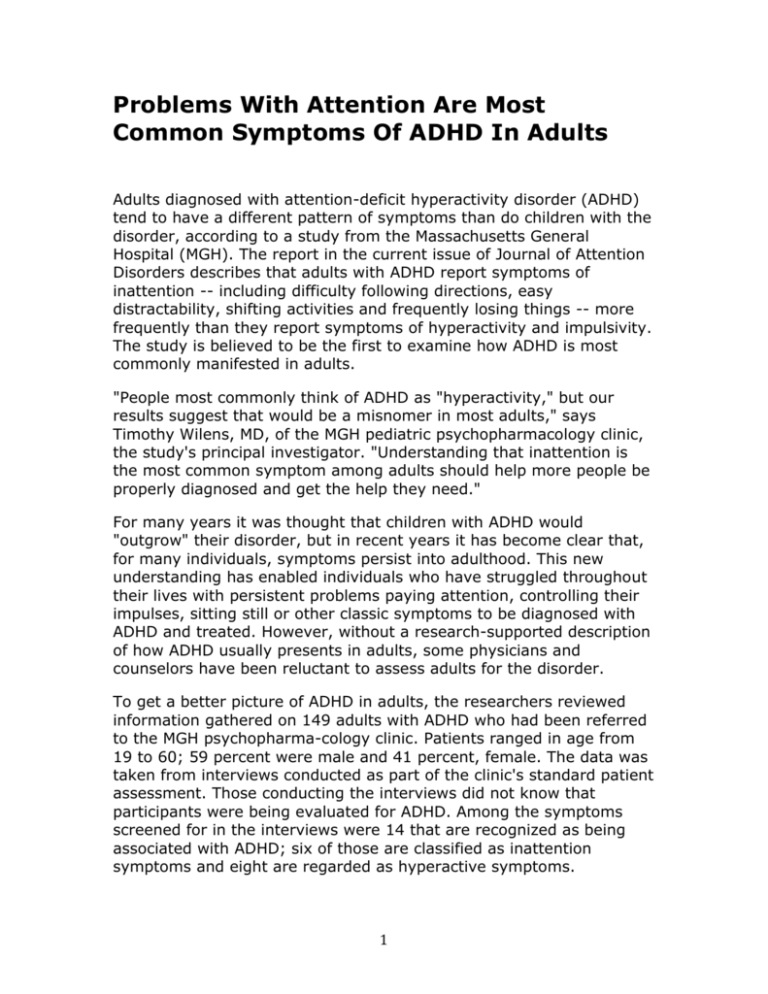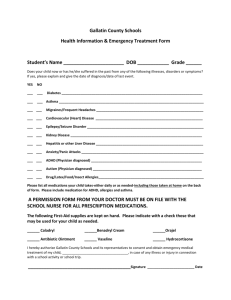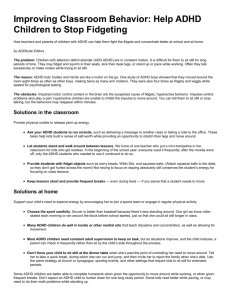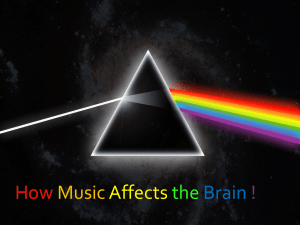Adult ADHD - NeuroCare Center Inc.
advertisement

Problems With Attention Are Most Common Symptoms Of ADHD In Adults Adults diagnosed with attention-deficit hyperactivity disorder (ADHD) tend to have a different pattern of symptoms than do children with the disorder, according to a study from the Massachusetts General Hospital (MGH). The report in the current issue of Journal of Attention Disorders describes that adults with ADHD report symptoms of inattention -- including difficulty following directions, easy distractability, shifting activities and frequently losing things -- more frequently than they report symptoms of hyperactivity and impulsivity. The study is believed to be the first to examine how ADHD is most commonly manifested in adults. "People most commonly think of ADHD as "hyperactivity," but our results suggest that would be a misnomer in most adults," says Timothy Wilens, MD, of the MGH pediatric psychopharmacology clinic, the study's principal investigator. "Understanding that inattention is the most common symptom among adults should help more people be properly diagnosed and get the help they need." For many years it was thought that children with ADHD would "outgrow" their disorder, but in recent years it has become clear that, for many individuals, symptoms persist into adulthood. This new understanding has enabled individuals who have struggled throughout their lives with persistent problems paying attention, controlling their impulses, sitting still or other classic symptoms to be diagnosed with ADHD and treated. However, without a research-supported description of how ADHD usually presents in adults, some physicians and counselors have been reluctant to assess adults for the disorder. To get a better picture of ADHD in adults, the researchers reviewed information gathered on 149 adults with ADHD who had been referred to the MGH psychopharma-cology clinic. Patients ranged in age from 19 to 60; 59 percent were male and 41 percent, female. The data was taken from interviews conducted as part of the clinic's standard patient assessment. Those conducting the interviews did not know that participants were being evaluated for ADHD. Among the symptoms screened for in the interviews were 14 that are recognized as being associated with ADHD; six of those are classified as inattention symptoms and eight are regarded as hyperactive symptoms. 1 The researchers found that, while many participants reported a combination of both inattention and hyperactive symptoms, 93 percent of participants reported a preponderance of inattention symptoms; those most frequently reported were difficulty sustaining attention, shifting activities and difficulty following through on tasks. While hyperactive symptoms were reported less frequently, those most commonly reported were fidgeting, interrupting or intruding, speaking out of turn and difficulty waiting one's turn. The researchers also found that participants who reported symptoms of other psychiatric or behavioral disorders were more likely to have hyperactive symptoms than those with no additional disorders. Although women with ADHD typically report fewer hyperactive symptoms throughout their lifetimes than do men, this study found no significant difference in current reported symptoms between male and female participants. Wilens notes that currently available data suggest that 2 to 5 percent of the adult population may have ADHD. "Anyone reading a list of ADHD symptoms might recognize some of those qualities in themselves, but the difference for people with ADHD is the vast number of symptoms, their continuation throughout life, and their magnitude. Instead of losing things about once a month, for example, someone with ADHD may misplace things four or five times a day," he says. "People diagnosed with ADHD as adults tell consistent and compelling stories about them-selves, about feeling that they were misunderstood, never fit in or were somehow "spinning their wheels" throughout their lives," Wilens continues. "Everyone I've worked with has been relieved to hear their diagnosis; they only wish they could have been diagnosed and treated years earlier." Wilens' co-authors are Rachael Millstein, the paper's first author; Thomas J. Spencer, MD; and Joseph Biederman, MD, director of the MGH pediatric psychopharmacology clinic 5/22/98 Adults with ADHD adapted from: National Institute of Mental Health: http://www.nimh.nih.gov/health/publications/attention-deficit-hyperactivitydisorder/what-are-the-symptoms-of-adhd-in-children.shtml 2 Massachusetts General Hospital: http://www2.massgeneral.org/schoolpsychiatry/info_adhd.asp Some children with ADHD continue to have it as adults. And many adults who have the disorder don't know it. They may feel that it is impossible to get organized, stick to a job, or remember and keep appointments. Daily tasks such as getting up in the morning, preparing to leave the house for work, arriving at work on time, and being productive on the job can be especially challenging for adults with ADHD. These adults may have a history of failure at school, problems at work, or difficult or failed relationships. Many have had multiple traffic accidents. Like teens, adults with ADHD may seem restless and may try to do several things at once, most of them unsuccessfully. They also tend to prefer "quick fixes," rather than taking the steps needed to achieve greater rewards. How is ADHD diagnosed in adults? Like children, adults who suspect they have ADHD should be evaluated by a licensed mental health professional. But the professional may need to consider a wider range of symptoms when assessing adults for ADHD because their symptoms tend to be more varied and possibly not as clear cut as symptoms seen in children. To be diagnosed with the condition, an adult must have ADHD symptoms that began in childhood and continued throughout adulthood. Health professionals use certain rating scales to determine if an adult meets the diagnostic criteria for ADHD. The mental health professional also will look at the person's history of childhood behavior and school experiences, and will interview spouses or partners, parents, close friends, and other associates. The person will also undergo a physical exam and various psychological tests. For some adults, a diagnosis of ADHD can bring a sense of relief. Adults who 3 have had the disorder since childhood, but who have not been diagnosed, may have developed negative feelings about themselves over the years. Receiving a diagnosis allows them to understand the reasons for their problems, and treatment will allow them to deal with their problems more effectively. How is ADHD treated in adults? Much like children with the disorder, adults with ADHD are treated with medication, psychotherapy, or a combination of treatments. Medications. ADHD medications, including extended-release forms, often are prescribed for adults with ADHD, but not all of these medications are approved for adults.16 However, those not approved for adults still may be prescribed by a doctor on an "off-label" basis. Although not FDA-approved specifically for the treatment of ADHD, antidepressants are sometimes used to treat adults with ADHD. Older antidepressants, called tricyclics, sometimes are used because they, like stimulants, affect the brain chemicals norepinephrine and dopamine. A newer antidepressant, venlafaxine (Effexor), also may be prescribed for its effect on the brain chemical norepinephrine. And in recent clinical trials, the antidepressant bupropion (Wellbutrin), which affects the brain chemical dopamine, showed benefits for adults with ADHD. Adult prescriptions for stimulants and other medications require special considerations. For example, adults often require other medications for physical problems, such as diabetes or high blood pressure, or for anxiety and depression. Some of these medications may interact badly with stimulants. An adult with ADHD should discuss potential medication options with his or her doctor. These and other issues must be taken into account when a medication is prescribed. 4 Education and psychotherapy. A professional counselor or therapist can help an adult with ADHD learn how to organize his or her life with tools such as a large calendar or date book, lists, reminder notes, and by assigning a special place for keys, bills, and paperwork. Large tasks can be broken down into more manageable, smaller steps so that completing each part of the task provides a sense of accomplishment. Psychotherapy, including cognitive behavioral therapy, also can help change one's poor self-image by examining the experiences that produced it. The therapist encourages the adult with ADHD to adjust to the life changes that come with treatment, such as thinking before acting, or resisting the urge to take unnecessary risks. 5








